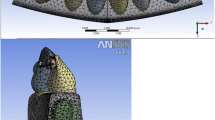Abstract.
During horizontal contact, the dental arch represents a link chain in which two convex articular surfaces are in contact and are tensioned by the dentogingival and dentoalveolar fibrous tissue. Joints composed of convex-convex surfaces are equivalent to stretched dimeric link chains whose links are in a mechanically unstable position under compression. Experiments on plaster models show that the dimensional stability of an articulated (dental) arch is considerably increased when a concave and a convex articular surface are in contact, as these joints are equivalent to an overlapping dimeric link chain whose links are in a mechanically stable position when under compression.
In the abraded denture of Stone Age man, horizontal interdental contacts of transversally concave-convex dental surfaces may be found extending even into the incisal region. Increased stability of the dental arch and reduced problems of incisal crowding are to be expected if an overlapping dimeric chain is produced morphologically in each horizontal contact by means of slight interproximal enamel reduction.
Zusammenfassung.
Der Zahnbogen stellt im horizontalen Kontakt eine Gelenkkette dar, in der sich zwei konvexe Gelenkflächen berühren und die durch den dentogingivalen und dentoalveolären Faserapparat verspannt sind. Gelenke mit konvex-konvexen Flächen sind äquivalent zu gestreckten dimeren Gelenkketten, deren Kettenglied sich unter Kompression in einer mechanisch instabilen Position befindet. In Modellversuchen wird gezeigt, dass ein Gelenk-(Zahn-)Bogen erheblich formstabiler ist, wenn sich in den Gelenkkontakten eine konkave und eine konvexe Gelenkfläche berühren, da diese Gelenke äquivalent zu einer überschlagenen dimeren Gelenkkette sind, deren Kettenglied sich unter Kompression in einer stabilen Lage befindet.
In den Abrasionsgebissen von Menschen der Frühgeschichte (Steinzeit, Eisenzeit ...) berühren sich selbst bis in den Frontzahnbereich hinein im horizontalen Schnitt solche konkav-konvexen Zahnoberflächen. Ein Stabilitätsgewinn für den Zahnbogen und eine Reduktion der Engstandproblematik kann erwartet werden, wenn in jedem horizontalen Zahnkontakt durch eine zarte approximale Schmelzreduktion morphologisch eine überschlagene dimere Kette hergestellt wird.
Similar content being viewed by others
Author information
Authors and Affiliations
Corresponding author
Rights and permissions
About this article
Cite this article
Ihlow, D., Kubein-Meesenburg, D., Fanghänel, J. et al. Biomechanics of the Dental Arch and Incisal Crowding. J Orofac Orthop 65, 5–12 (2004). https://doi.org/10.1007/s00056-004-0022-y
Received:
Accepted:
Issue Date:
DOI: https://doi.org/10.1007/s00056-004-0022-y




